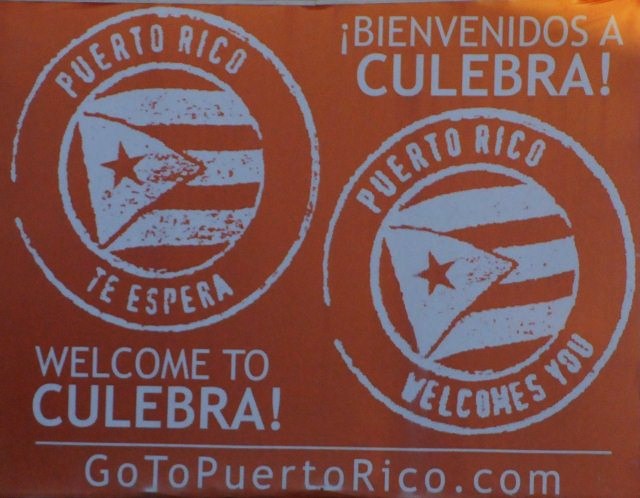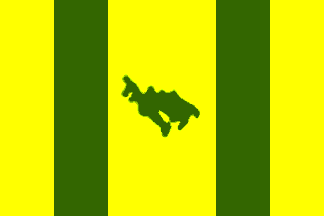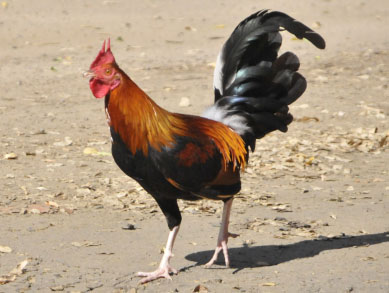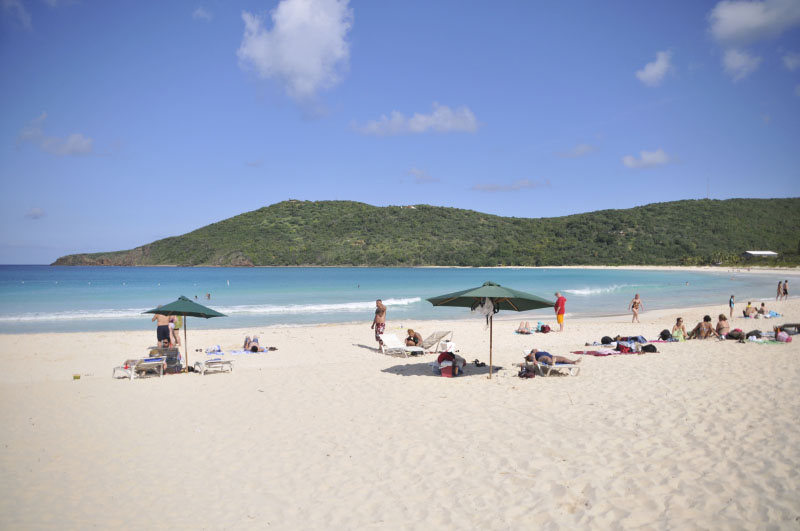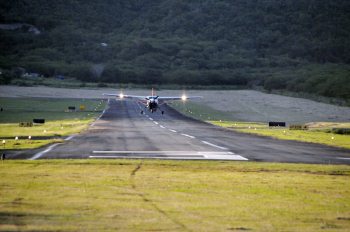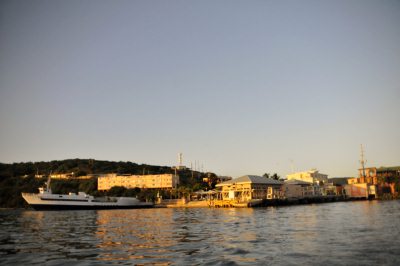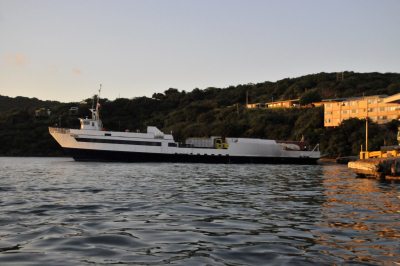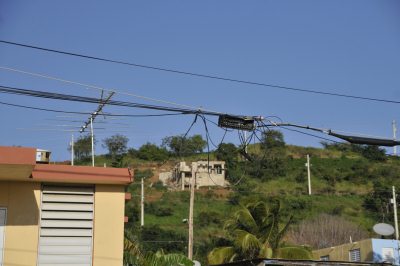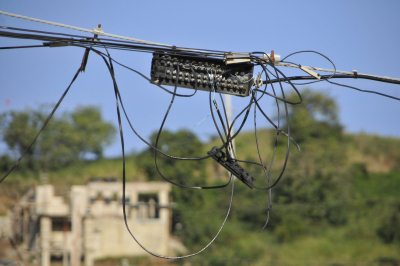Culebra

|
Culebra, Puerto Rico
Isla Culebra, Spanish pronunciation: Ku-lee-bra or "Snake Island" is an island-municipality of Puerto Rico originally called Isla Pasaje and Isla de San Ildefonso. It is located approximately seventeen miles east of the Puerto Rican mainland, twelve miles west of St Thomas and nine miles north of Vieques. The island is also known as Isla Chiquita ("Little Island") and Última Virgen ("Last Virgin", reflecting it’s position at the end of the Virgin Islands archipelago). Residents of the island are known as Culebrenses.

We saw traditional cast fishing

The Museum of Culebra, sadly closed the times we drove past
In 1902 Culebra was
integrated as a part of Vieques. A bird refuge was established on the 27th of
February 1909. In 1939, the US Navy began to use the Culebra Archipelago as a
gunnery and bombing practice site, to prepare for the US' involvement in
World War II. In 1971 the people of Culebra began the Navy-Culebra protests.
Four years later, in 1975, the use of Culebra as a gunnery range ceased and all
operations were moved to Vieques. Culebra was declared an independent island municipality in 1917. The first democratically elected government was put into place in 1960. Prior to this, the government of Puerto Rico appointed delegates to administer the island.
Flag: The Culebra flag consists of five vertical stripes, three alternate
yellow and two green ones. The yellow central stripe has the map of Culebra in
green. Coat of Arms: This crown consists of sterns of two ships with their sails filled by the wind. The cross and the episcopal walking stick symbolize Bishop San Ildefonso, because originally the island was called San Ildefonso de la Culebra. The serpent (culebra means serpent) symbolizes its name. An armed arm from the Coat of Arms of the Escudero family, first settlers of the island. The laurel cross refers to the civic triumph reached when Culebra obtained the evacuation of the United States Navy from the island.
Good looking cockerels are all over the island - just doin' their ting
This cat didn't belong to these people, he just joined them for the day
Demographics: Barrios (Districts/Wards)
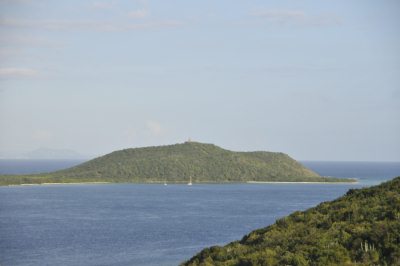  Culebrita seen from Zoni Beach.
Geography: Culebra is an archipelago about seven by five miles,
consisting of the main island and twenty-three smaller islands that lie off its
coast. The largest of these cays are: Culebrita to the east, Cayo Norte to the
northeast, and Cayo Luis Pena and Cayo Lobo to the west. The smaller islands
include Cayo Ballena, Cayos Geniqui, Arrecife Culebrita, Las Hermanas, El Mono,
Cayo Lobito, Cayo Botijuela, Alcarraza, Los Gemelos, and Piedra Steven. Islands
in the archipelago are arid, meaning they have no rivers or streams. All of the
fresh water is brought from Puerto Rico via
Vieques. Culebra is characterized by an irregular topography resulting in a long intricate shoreline. The coast is marked by cliffs, sandy coral beaches and mangrove forests. Inland, the tallest point on the island is Mount Resaca, with an elevation of six hundred and fifty feet. Ensenada Honda is the largest harbour on the island and is considered to be the most hurricane secure harbor in the Caribbean.
The lovely hand-painted signs at the entrance to Tamarindo Beach
Nature Reserves: These small islands are all classified as nature reserves and several nature reserves also exist on the main island. On the 26th of June 1903 President Theodore Roosevelt established the Culebra Naval Reservation. One of the oldest bird sanctuaries in United States territory was established in Culebra on the 27th of February 1909 again by President Roosevelt. The Culebra Island Giant Anole (Anolis roosevelti, Xiphosurus roosevelti is an extremely rare or possibly extinct lizard of the Anolis genus. It is native to Culebra Island and was named in honour of Theodore Roosevelt Jnr. who was the governor of Puerto Rico at that time. There are bird sanctuaries on many of the islands as well as turtle nesting sites. Leatherback, green sea and hawksbill sea turtles use the beaches for nesting. The archipelago is home to brown boobies, laughing gulls, sooty, noddy and bridled terns. An estimated fifty thousand sea birds find their way back to these sanctuaries every year. These nature reserves comprise 1568 acres of the archipelagos seven thousand acres and are protected by the US Fish and Wildlife Service. Culebra has no natural large mammals. However, a population of white-tailed deer introduced in 1966 can be found on the eastern region of the island.

The bridge going over the little bit of Culebra not connected, used to open for two fishing boats - that no longer use it
Tourism: Culebra is a popular weekend tourist destination for
Mainland Puerto Ricans, Americans and residents of Vieques. Because of the
"arid" nature of the island there is no run-off from rivers or streams resulting
in very clear water. Culebra has many beautiful beaches including Flamenco Beach (Playa Flamenco), which can be reached by shuttle buses from the ferry. The beach extends for a mile of white coral sand and is framed beautifully by arid tree-covered hills. The beach is protected by the Department of Natural and Environment Resources as a Marine Wildlife Reserve. The area west of Flamenco
Beach and the adjacent Flamenco Point were used for joint US States Navy /
Marine Corps military exercises until 1975. Many military relics, including
tanks, remain in the area. Culebra and Vieques offered the U.S. military an
experience of great value to the battles in the Pacific as a feasible training
area for the Fleet Marine Force in amphibious exercises for beach landings and
naval gunfire support testing. Culebra and Vieques were the two components of
the Atlantic Fleet Weapons Range Inner Range. In recent years, only the
shortened term "Inner Range" was used. Other beaches are only accessible by private car or boats. Of the smaller islands, only Culebrita and Luis Pina permit visitors and can be accessible via water taxis from Culebra. Hiking and nature photography are encouraged on the small islands. However, activities which would disturb the nature reserves are prohibited, that is camping, littering and cars. Camping, however, is allowed on Playa Flamenco throughout the year, reservations are recommended. Culebra is also a popular destination for scuba divers because of the many reefs throughout the archipelago and the crystal clear waters.
Landmarks and places of interest: Flamenco Beach (with its number two ranking), Zoni Beach and beaches called, Brava, Las Vacas, Larga, Pueblo Espanol, Punta Solado, Resaca, Tamarindo and Toruga Beach Festivals and events: February has a windsurfing competition, March has a fishing tournament, June has patron festivities and November has craft festivities.
Transportation: Culebra has a small airport with domestic service to the mainland and Vieques.
Ferry service is available from Fajardo.
We saw some
interesting wiring
  And of course the odd "one careful
owner"
  A huge big fat bee and stunning red
Hibiscus
  One of the few hotels in the capital
Dewey www.villaboheme.com and a restaurant Bear wanted to go to by Baby Beez
www.mamacitasguesthouse.com
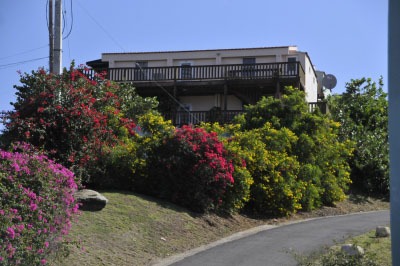      Baldy (see votes
please) and Curly were going from here to Vieques, change of plan,
heading for Puerto Rico in the morning to get better details/map/info for
Vieques
ALL IN ALL A SMASHING LITTLE
ISLAND
I'M TOTALLY IN LOVE WITH THE
PLACE
..................................................Ouch
|

